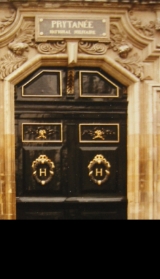
Prytanée National Militaire
Encyclopedia
The Prytanée National Militaire, originally Collège Royal Henry-Le-Grand, is a French school managed by the military, offering regular secondary education
as well as special preparatory school
classes, equivalent in level to the first years of university
, for students who wish to enter French military academies. The school is located in western France in the city of La Flèche
.
established a castle in La Flèche, where Antoine de Bourbon, king of Navarre, and his wife Jeanne d'Albret, future parents of Henry IV, resided in 1552. The castle was given to the Jesuits by Henri IV in 1604 to found a College under the name of "Collège Royal Henry-Le-Grand", in order "to select and train the best minds of the time".
 The first Jesuits left Pont-à-Mousson
The first Jesuits left Pont-à-Mousson
on 16 October 1603, and reached La Flèche on 2 January 1604. They started to teach grammar
, rhetorics, Latin
, Greek, Hebrew
, philosophy
, mathematics
, theology
. A foundation edict was issued at Fontainebleau
in May 1607, in which the building started to take its present shape.
 René Descartes
René Descartes
was one of the first and most illustrious students of the school from 1607 to 1615, and introduced the school in his Discourse on Method
under the phrase "I was in one of the most famous schools of Europe".
The College continued to expand, and upon the death of Henry IV, a vast church was built, in which the hearts of Henry IV and his wife queen Marie de Medicis were enshrined.
, who became an early missionary to Canada and became Minister of the College upon his return in 1614. When he went back to Canada, he was accompanied by Charles Lalemant, another alumni of the school. Paul Le Jeune
, also a student of the College, is considered as the "father of the Jesuit missions in New France
", and was the Superior of the Jesuits in Quebec from 1632 to 1639. Others were Erard Bille, Jacques Buteux
, Nicolas Adam
, Barthélemy Vimont
, Paul Ragueneau
, Claude de Quentin, Isaac Jogues
.
In China also, numerous students of the College became active participants to the missions.Three of the five Jesuits sent by Louis XIV to China were from the Collège: Jean de Fontaney
, the Superior of the mission, who had been a professor of mathematics there and became Rector of the school until 1710 after his return from China; Joachim Bouvet
, who was a philosophy student in 1676, became a teacher to the Kangxi Emperor; Claude Visdelou, who was a repetitor and a teacher at the school from 1676 to 1678. Others included Guillaume le Couteux, Pierre Foureau, Charles de Broissia, Emeric de Chavagnac, Jean-François Fouquet, Joseph Labbe.
Around 1650, the College became a center of cosmopolistic learning, as "Americans, Indians, Tartars, Russians, and even Chinese visited it". In 1751, two Chinese students were enrolled: Yang Dewang (Etienne Yang Tche-teh), and Gao Ren (Louis Kao Fen).
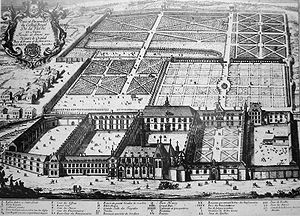
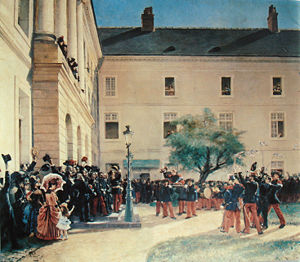
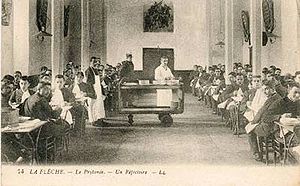 In 1764, following the expulsion of the Jesuits, after a lapse of two years, the school was transformed by Louis XV
In 1764, following the expulsion of the Jesuits, after a lapse of two years, the school was transformed by Louis XV
and Choiseul
into a military institution designed to train young cadet
s for admission to the École Militaire
, the "École de Cadets ou École Militaire préparatoire à l’École Militaire du Champ de Mars". These efforts at creating military institutions followed military defeats in the Seven Years' War
. The school was reserved to 250 students of noble extraction, as well as sons of officers who were wounded or died in combat, and the sons of the Chevaliers de Saint-Louis
.
attempted to close the school, but it was re-established by Louis XVI
, who gave its management to the "Fathers of the Christian Doctrine" (Pères de la Doctrine chrétienne). Among others, they educated the future General Bertrand
, who accompanied Napoléon to Saint Helena
, and the two Chappe brothers, who invented the aerial telegraph.
The College was closed in 1793 following the advent of the French revolution
. For a while, the buildings were used for a variety of purposes, such as becoming a cordonery for the Army of the Republic.
(literally "Presidents"), an executive body acting as the religious and political heart of ancient Greek cities. As Napoleon had moved to Fontainebleau to establish his court, he had decided to transfer the "École Spéciale Militaire de Fontainebleau" to Paris, and the "Prytanée de Saint-Cyr" to La Flèche. Since then various names were adopted for the school, such as "École royale militaire" (1814–1830), Collège royal militaire (1831–1848), Collège national militaire (1848–1853), Prytanée impérial militaire (1853–1870), Prytanée militaire and Prytanée national militaire (since 1870).
During World War II
in 1940, the Prytanée had to be moved for a few years successively to Billom
, Valence then Briançon
.
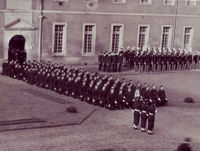 Today the Prytanée provides secondary education and also has "Classes préparatoires", that is, preparatory classes to the entrance examinations of the French elite Grandes Écoles
Today the Prytanée provides secondary education and also has "Classes préparatoires", that is, preparatory classes to the entrance examinations of the French elite Grandes Écoles
, such as École polytechnique
, the Navy École Navale
, the Army École Spéciale Militaire de Saint-Cyr
, the École de l'Air and various civilian engineering or commercial graduate schools.
The school's students are nicknamed "Brutions", as a classic reference to the inhabitants of the Bruttium region of Roman Italy, who had a reputation for their roughness and fighting spirit.
 The school grades received by students are even today symbolized by military insignias which are worn on the traditional uniform ("Uniforme de tradition"), starting with "Sergent-Major" (4 golden chevrons) for the top of a class, "Sergent" (3 golden chevrons), "Caporal-Chef" (2 red and 1 golden chevrons), and finally "Caporal" (2 red chevrons). Typically, the top 10 students of each class during a given quarter would receive such insignias.
The school grades received by students are even today symbolized by military insignias which are worn on the traditional uniform ("Uniforme de tradition"), starting with "Sergent-Major" (4 golden chevrons) for the top of a class, "Sergent" (3 golden chevrons), "Caporal-Chef" (2 red and 1 golden chevrons), and finally "Caporal" (2 red chevrons). Typically, the top 10 students of each class during a given quarter would receive such insignias.
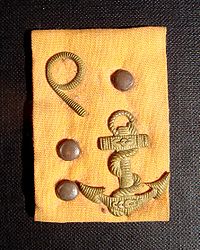 Students also have colored shoulder badges for each year, attached to the daily fatigues
Students also have colored shoulder badges for each year, attached to the daily fatigues
("Uniforme de travail"), starting with blue for the first year of high school, orange for the second, and green for the third. These badges can further be adorned with various small symbols and decorations, especially expressing the type of career each student is aspiring to.
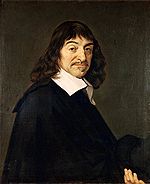
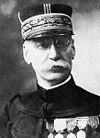
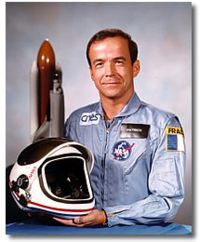
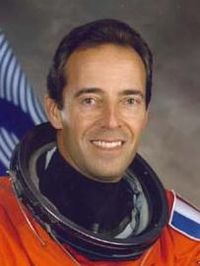 The Prytanée has trained various military and non-military celebrities. In chronological order:
The Prytanée has trained various military and non-military celebrities. In chronological order:
Secondary education
Secondary education is the stage of education following primary education. Secondary education includes the final stage of compulsory education and in many countries it is entirely compulsory. The next stage of education is usually college or university...
as well as special preparatory school
University-preparatory school
A university-preparatory school or college-preparatory school is a secondary school, usually private, designed to prepare students for a college or university education...
classes, equivalent in level to the first years of university
University
A university is an institution of higher education and research, which grants academic degrees in a variety of subjects. A university is an organisation that provides both undergraduate education and postgraduate education...
, for students who wish to enter French military academies. The school is located in western France in the city of La Flèche
La Flèche
La Flèche is a municipality located in the French department of Sarthe and the region of Pays de la Loire in the Loire Valley. This is the sub-prefecture of the South-Sarthe, the chief district and the chief city of a canton. This is the second most populous city of the department. The city is part...
.
History
During the 16th century, Françoise, duchess of Alençon, and grandmother to the future Henry IVHenry IV of France
Henry IV , Henri-Quatre, was King of France from 1589 to 1610 and King of Navarre from 1572 to 1610. He was the first monarch of the Bourbon branch of the Capetian dynasty in France....
established a castle in La Flèche, where Antoine de Bourbon, king of Navarre, and his wife Jeanne d'Albret, future parents of Henry IV, resided in 1552. The castle was given to the Jesuits by Henri IV in 1604 to found a College under the name of "Collège Royal Henry-Le-Grand", in order "to select and train the best minds of the time".
The Jesuit College (1604–1762)

Pont-à-Mousson
Pont-à-Mousson is a commune in the Meurthe-et-Moselle department in north-eastern France.Population : 14,592 . It is an industrial town , situated on the Moselle River...
on 16 October 1603, and reached La Flèche on 2 January 1604. They started to teach grammar
Grammar
In linguistics, grammar is the set of structural rules that govern the composition of clauses, phrases, and words in any given natural language. The term refers also to the study of such rules, and this field includes morphology, syntax, and phonology, often complemented by phonetics, semantics,...
, rhetorics, Latin
Latin
Latin is an Italic language originally spoken in Latium and Ancient Rome. It, along with most European languages, is a descendant of the ancient Proto-Indo-European language. Although it is considered a dead language, a number of scholars and members of the Christian clergy speak it fluently, and...
, Greek, Hebrew
Hebrew language
Hebrew is a Semitic language of the Afroasiatic language family. Culturally, is it considered by Jews and other religious groups as the language of the Jewish people, though other Jewish languages had originated among diaspora Jews, and the Hebrew language is also used by non-Jewish groups, such...
, philosophy
Philosophy
Philosophy is the study of general and fundamental problems, such as those connected with existence, knowledge, values, reason, mind, and language. Philosophy is distinguished from other ways of addressing such problems by its critical, generally systematic approach and its reliance on rational...
, mathematics
Mathematics
Mathematics is the study of quantity, space, structure, and change. Mathematicians seek out patterns and formulate new conjectures. Mathematicians resolve the truth or falsity of conjectures by mathematical proofs, which are arguments sufficient to convince other mathematicians of their validity...
, theology
Theology
Theology is the systematic and rational study of religion and its influences and of the nature of religious truths, or the learned profession acquired by completing specialized training in religious studies, usually at a university or school of divinity or seminary.-Definition:Augustine of Hippo...
. A foundation edict was issued at Fontainebleau
Fontainebleau
Fontainebleau is a commune in the metropolitan area of Paris, France. It is located south-southeast of the centre of Paris. Fontainebleau is a sub-prefecture of the Seine-et-Marne department, and it is the seat of the arrondissement of Fontainebleau...
in May 1607, in which the building started to take its present shape.

René Descartes
René Descartes ; was a French philosopher and writer who spent most of his adult life in the Dutch Republic. He has been dubbed the 'Father of Modern Philosophy', and much subsequent Western philosophy is a response to his writings, which are studied closely to this day...
was one of the first and most illustrious students of the school from 1607 to 1615, and introduced the school in his Discourse on Method
Discourse on Method
The Discourse on the Method is a philosophical and autobiographical treatise published by René Descartes in 1637. Its full name is Discourse on the Method of Rightly Conducting One's Reason and of Seeking Truth in the Sciences .The Discourse on Method is best known...
under the phrase "I was in one of the most famous schools of Europe".
The College continued to expand, and upon the death of Henry IV, a vast church was built, in which the hearts of Henry IV and his wife queen Marie de Medicis were enshrined.
Missions to China and the Americas
Many of the Jesuit missionaries who went to the Americas or China during the 17th century had been trained at the College. Among them were Énemond MasséÉnemond Massé
Énemond Massé was a French Jesuit missionary, one of the first Jesuits sent to New France.-Life:Massé was born at Lyon. Before leaving for French Canada, he was the confessor of Antoinette de Pons, the Marquise de Guercheville...
, who became an early missionary to Canada and became Minister of the College upon his return in 1614. When he went back to Canada, he was accompanied by Charles Lalemant, another alumni of the school. Paul Le Jeune
Paul Le Jeune
Paul Le Jeune was a French Jesuit missionary in French Canada.-Biography:Le Jeune was born in Vitry-le-François in the region of Champagne, France in 1591...
, also a student of the College, is considered as the "father of the Jesuit missions in New France
New France
New France was the area colonized by France in North America during a period beginning with the exploration of the Saint Lawrence River by Jacques Cartier in 1534 and ending with the cession of New France to Spain and Great Britain in 1763...
", and was the Superior of the Jesuits in Quebec from 1632 to 1639. Others were Erard Bille, Jacques Buteux
Jacques Buteux
Jacques Buteux was a French-born Jesuit who became a missionary in Canada.Buteux came to Canada in 1634 and was assigned to Trois-Rivières, where he ministered until his death in 1652. His death took place during a mission journey. His party was attacked by a troop of Iroquois lying in ambush. He...
, Nicolas Adam
Nicolas Adam
Nicolas "Nic" Dominique Adam was a Luxembourgian gymnast who competed in the 1912 Summer Olympics....
, Barthélemy Vimont
Barthélemy Vimont
Barthélemy Vimont was a French Jesuit missionary in New France, North America.- Biography :Born at Lisieux, he entered the Society of Jesus at Rouen in 1613...
, Paul Ragueneau
Paul Ragueneau
Paul Ragueneau is known most notable as a Catholic Jesuit missionary. He was born in Paris and died in the same city. He is sometimes confused with his elder brother François, also a Jesuit. Father François Ragueneau accompanied Father Charles Lalemant who was returning to Canada in 1628. Their...
, Claude de Quentin, Isaac Jogues
Isaac Jogues
Isaac Jogues was a Jesuit priest, missionary, and martyr who traveled and worked among the native populations in North America. He gave the original European name to Lake George, calling it Lac du Saint Sacrement, Lake of the Blessed Sacrament. In 1646, Jogues was martyred by the Mohawks near ...
.
In China also, numerous students of the College became active participants to the missions.Three of the five Jesuits sent by Louis XIV to China were from the Collège: Jean de Fontaney
Jean de Fontaney
Jean de Fontaney was a French Jesuit who led a mission to China in 1687.Jean de Fontaney had been a teacher of mathematics and astronomy at the College Louis le Grand...
, the Superior of the mission, who had been a professor of mathematics there and became Rector of the school until 1710 after his return from China; Joachim Bouvet
Joachim Bouvet
Joachim Bouvet was a French Jesuit who worked in China, and the leading member of the Figurist movement.-Biography:...
, who was a philosophy student in 1676, became a teacher to the Kangxi Emperor; Claude Visdelou, who was a repetitor and a teacher at the school from 1676 to 1678. Others included Guillaume le Couteux, Pierre Foureau, Charles de Broissia, Emeric de Chavagnac, Jean-François Fouquet, Joseph Labbe.
Around 1650, the College became a center of cosmopolistic learning, as "Americans, Indians, Tartars, Russians, and even Chinese visited it". In 1751, two Chinese students were enrolled: Yang Dewang (Etienne Yang Tche-teh), and Gao Ren (Louis Kao Fen).
Cadets school (1764–1776)



Louis XV of France
Louis XV was a Bourbon monarch who ruled as King of France and of Navarre from 1 September 1715 until his death. He succeeded his great-grandfather at the age of five, his first cousin Philippe II, Duke of Orléans, served as Regent of the kingdom until Louis's majority in 1723...
and Choiseul
Choiseul
-People:*Choiseul . Holders include:-** Caesar, duc de Choiseul , French marshal and diplomat, generally known for the best part of his life as marshal du Plessis-Praslin** Claude de Choiseul , marshal of France in 1693...
into a military institution designed to train young cadet
Cadet
A cadet is a trainee to become an officer in the military, often a person who is a junior trainee. The term comes from the term "cadet" for younger sons of a noble family.- Military context :...
s for admission to the École Militaire
École Militaire
The École Militaire is a vast complex of buildings housing various military training facilities located in the 7th arrondissement of Paris, France, southeast of the Champ de Mars....
, the "École de Cadets ou École Militaire préparatoire à l’École Militaire du Champ de Mars". These efforts at creating military institutions followed military defeats in the Seven Years' War
Seven Years' War
The Seven Years' War was a global military war between 1756 and 1763, involving most of the great powers of the time and affecting Europe, North America, Central America, the West African coast, India, and the Philippines...
. The school was reserved to 250 students of noble extraction, as well as sons of officers who were wounded or died in combat, and the sons of the Chevaliers de Saint-Louis
Order of Saint Louis
The Royal and Military Order of Saint Louis was a military Order of Chivalry founded on 5 April 1693 by Louis XIV and named after Saint Louis . It was intended as a reward for exceptional officers, and is notable as the first decoration that could be granted to non-nobles...
.
College (1776–1793)
In 1776, the Count of St GermainCount of St Germain
The Count of St. Germain has been variously described as a courtier, adventurer, charlatan, inventor, alchemist, pianist, violinist and an amateur composer. He achieved great prominence in European high society of the mid-1700s, and since then various scholars have linked him to mysticism,...
attempted to close the school, but it was re-established by Louis XVI
Louis XVI of France
Louis XVI was a Bourbon monarch who ruled as King of France and Navarre until 1791, and then as King of the French from 1791 to 1792, before being executed in 1793....
, who gave its management to the "Fathers of the Christian Doctrine" (Pères de la Doctrine chrétienne). Among others, they educated the future General Bertrand
Henri Gratien, Comte Bertrand
Henri-Gatien, Comte Bertrand , French general, was born at Châteauroux, Indre as a member of a well-to-do bourgeois family....
, who accompanied Napoléon to Saint Helena
Saint Helena
Saint Helena , named after St Helena of Constantinople, is an island of volcanic origin in the South Atlantic Ocean. It is part of the British overseas territory of Saint Helena, Ascension and Tristan da Cunha which also includes Ascension Island and the islands of Tristan da Cunha...
, and the two Chappe brothers, who invented the aerial telegraph.
The College was closed in 1793 following the advent of the French revolution
French Revolution
The French Revolution , sometimes distinguished as the 'Great French Revolution' , was a period of radical social and political upheaval in France and Europe. The absolute monarchy that had ruled France for centuries collapsed in three years...
. For a while, the buildings were used for a variety of purposes, such as becoming a cordonery for the Army of the Republic.
Prytanée Militaire (1808-today)
In 24 March 1808, Napoléon renamed the school "Prytanée Militaire", in a classic reference to the Greek prytaneisPrytaneis
The Prytaneis were the executives of the boule of ancient Athens. The term is probably of pre-Greek origin ....
(literally "Presidents"), an executive body acting as the religious and political heart of ancient Greek cities. As Napoleon had moved to Fontainebleau to establish his court, he had decided to transfer the "École Spéciale Militaire de Fontainebleau" to Paris, and the "Prytanée de Saint-Cyr" to La Flèche. Since then various names were adopted for the school, such as "École royale militaire" (1814–1830), Collège royal militaire (1831–1848), Collège national militaire (1848–1853), Prytanée impérial militaire (1853–1870), Prytanée militaire and Prytanée national militaire (since 1870).
During World War II
World War II
World War II, or the Second World War , was a global conflict lasting from 1939 to 1945, involving most of the world's nations—including all of the great powers—eventually forming two opposing military alliances: the Allies and the Axis...
in 1940, the Prytanée had to be moved for a few years successively to Billom
Billom
Billom is a commune in the Puy-de-Dôme department in Auvergne in central France.-People:It was the birthplace of philosopher Georges Bataille.Hugh Aycelin was a French Cardinal.-References:*...
, Valence then Briançon
Briançon
Briançon a commune in the Hautes-Alpes department in the Provence-Alpes-Côte d'Azur region in southeastern France. It is a sub-prefecture of the department....
.
Today

Grandes écoles
The grandes écoles of France are higher education establishments outside the main framework of the French university system. The grandes écoles select students for admission based chiefly on national ranking in competitive written and oral exams...
, such as École polytechnique
École Polytechnique
The École Polytechnique is a state-run institution of higher education and research in Palaiseau, Essonne, France, near Paris. Polytechnique is renowned for its four year undergraduate/graduate Master's program...
, the Navy École Navale
École Navale
The École Navale is the French Naval Academy in charge of the education of the officers of the French Navy.The academy was founded in 1830 by the order of King Louis-Philippe...
, the Army École Spéciale Militaire de Saint-Cyr
École Spéciale Militaire de Saint-Cyr
The École Spéciale Militaire de Saint-Cyr is the foremost French military academy. Its official name is . It is often referred to as Saint-Cyr . Its motto is "Ils s'instruisent pour vaincre": literally "They study to vanquish" or "Training for victory"...
, the École de l'Air and various civilian engineering or commercial graduate schools.
The school's students are nicknamed "Brutions", as a classic reference to the inhabitants of the Bruttium region of Roman Italy, who had a reputation for their roughness and fighting spirit.
Insignas


Fatigues
-Clothing:* Nowadays, usually a synonym of battledress.* Formerly, work clothes worn by soldiers to avoid getting their uniforms dirty in non-combat manual work* Camouflage-patterned clothing found in civilian fashions...
("Uniforme de travail"), starting with blue for the first year of high school, orange for the second, and green for the third. These badges can further be adorned with various small symbols and decorations, especially expressing the type of career each student is aspiring to.
Famous alumni




- Marin MersenneMarin MersenneMarin Mersenne, Marin Mersennus or le Père Mersenne was a French theologian, philosopher, mathematician and music theorist, often referred to as the "father of acoustics"...
(1558–1648), theologian. - Pierre SéguierPierre Séguier-Early years:Born in Paris, France of a prominent legal family originating in Quercy. His grandfather, Pierre Séguier , was président à mortier in the parlement of Paris from 1554 to 1576, and the chancellor's father, Jean Séguier, a seigneur d'Autry, was civil lieutenant of Paris at the time of...
, statesman and Chancellor of France (1588–1672). - René Descartes, philosopher (1596–1650).
- Comte de GuébriantJean-Baptiste Budes, Comte de GuébriantJean-Baptiste Budes, comte de Guébriant was marshal of France.-Life:He was born at Plessis-Budes, near St Brieuc, in a Breton family...
(1602–1643), Marshal of FranceMarshal of FranceThe Marshal of France is a military distinction in contemporary France, not a military rank. It is granted to generals for exceptional achievements...
. - La RochefoucauldFrançois de La Rochefoucauld (writer)François VI, Duc de La Rochefoucauld, Prince de Marcillac was a noted French author of maxims and memoirs. The view of human conduct his writings describe has been summed up by the words "everything is reducible to the motive of self-interest", though the term "gently cynical" has also been applied...
(1613–1680), writer. - François de LavalFrançois de LavalThis article is in part a sermon and generally comes close to hagiography.Blessed François-Xavier de Montmorency-Laval was the first Roman Catholic bishop of Quebec and was one of the most influential men of his day. He was appointed when he was 36 years old by Pope Alexander VII. He was a member...
(1623–1708), first Bishop of New France. - Jean PicardJean PicardJean-Felix Picard was a French astronomer and priest born in La Flèche, where he studied at the Jesuit Collège Royal Henry-Le-Grand. He was the first person to measure the size of the Earth to a reasonable degree of accuracy in a survey conducted in 1669–70, for which he is honored with a...
(1629–1682), astronomer. - James Fitz-JamesJames FitzJames, 1st Duke of BerwickJames FitzJames, 1st Duke of Berwick, 1st Duke of Fitz-James, 1st Duke of Liria and Jérica was an Anglo-French military leader, illegitimate son of King James II of England by Arabella Churchill, sister of the 1st Duke of Marlborough...
(1670–1734), Duke of Berwick and marshall of France. - du Petit Thouars (1760–1798), Navy officer, hero of the Battle of Aboukir BayBattle of the NileThe Battle of the Nile was a major naval battle fought between British and French fleets at Aboukir Bay on the Mediterranean coast of Egypt from 1–3 August 1798...
. - Claude Chappe (1763–1805), inventor of the optical telegraph.
- Bertrand (1773–1844), General, follower of Napoleon at Saint HelenaSaint HelenaSaint Helena , named after St Helena of Constantinople, is an island of volcanic origin in the South Atlantic Ocean. It is part of the British overseas territory of Saint Helena, Ascension and Tristan da Cunha which also includes Ascension Island and the islands of Tristan da Cunha...
- PélissierAimable Jean Jacques PélissierAimable Jean Jacques Pélissier, 1st Duc de Malakoff , was a marshal of France.-Biography:He was born at Maromme , of a family of prosperous artisans, his father being employed in a powder-magazine...
(1794–1864), Marshal of France. - René François Regnier (1794–1881), ecclesiastical writer.
- Achille Baraguey d'HilliersAchille Baraguey d'HilliersLouis-Achille Baraguey d'Hilliers, 1st Comte Baraguey d'Hilliers was a Marshal of France and politician.Baraguey d'Hilliers was born in Paris, the son of the French revolutionary general Louis Baraguey d'Hilliers...
(1795–1878), Marshall of France. - Antoine Brutus MenierAntoine Brutus MenierJean-Antoine Brutus Menier was a French entrepreneur and founder of the Menier family of chocolatiers. Born in Germain-de-Bourgeuil, Indre-et-Loire, he was the third child in a family of merchants. In 1811 Antoine Brutus Menier was enrolled in the La Flèche Military Academy where he studied the...
(1795–1853), entrepreneur and founder of Chocolat MenierMenier familyThe Menier family of Noisiel, France, was a prominent family of chocolatiers who began as pharmaceutical manufacturers in Paris in 1816. They would build a highly successful enterprise, expanding to London, England, and New York City, New York, USA. The Menier Chocolate Co. remained in the family...
. - Antoine François PrévostAntoine François PrévostAntoine François Prévost , usually known simply as the Abbé Prévost, was a French author and novelist.- Life and works :...
(1797–1863), novelist. - Alessandro BarnabòAlessandro BarnabòAlessandro Barnabò was an Italian Catholic Cardinal and Prefect of the Congregation Propaganda Fide.-Early life:Barnabò was born on 2 March 1801 in Foligno....
(1801–1874), Catholic CardinalCardinal (Catholicism)A cardinal is a senior ecclesiastical official, usually an ordained bishop, and ecclesiastical prince of the Catholic Church. They are collectively known as the College of Cardinals, which as a body elects a new pope. The duties of the cardinals include attending the meetings of the College and...
. - Louis d'Aurelle de PaladinesLouis d'Aurelle de PaladinesLouis Jean-Baptiste d'Aurelle de Paladines was a French general.He was born at Le Malzieu-Ville, Lozère, educated at the Prytanée National Militaire and St Cyr, and entered the army as sub-lieutenant of foot in 1824...
(1804–1877), General. - Courtot de CisseyErnest Courtot de CisseyErnest Louis Octave Courtot de Cissey was a French general.He was born in Paris, educated at the Prytanée National Militaire, and after passing through St Cyr, entered the army in 1832, becoming captain in 1839....
(1810–1882), General. - BourbakiCharles Denis BourbakiCharles Denis Sauter Bourbaki was a French general.He was born at Pau, the son of Greek colonel Constantin Denis Bourbaki, who died in the War of Independence in 1827...
(1816–1897), General. - Adrien Joseph Deutsch (1818–1895)
- Louis RosselLouis RosselLouis-Nathaniel Rossel was a French army officer and politician. On 19 March 1871 he became the only senior French officer to join up with the Paris Commune, and here he played an important rôle as Minister of War....
(1844–1871), Minister of War in the Paris CommuneParis CommuneThe Paris Commune was a government that briefly ruled Paris from March 18 to May 28, 1871. It existed before the split between anarchists and Marxists had taken place, and it is hailed by both groups as the first assumption of power by the working class during the Industrial Revolution...
. - GallieniJoseph GallieniJoseph Simon Gallieni was a French soldier, most active as a military commander and administrator in the French colonies and finished his career during the First World War. He was made Marshal of France posthumously in 1921...
(1849–1916), Marshal of France. - Amédée-François LamyAmédée-François LamyAmédée-François Lamy was born at Mougins, in the French département of Alpes-Maritimes on February 7, 1858 and died in the battle of Kousséri on April 22, 1900....
(1858–1900), French officer, conqueror of ChadChadChad , officially known as the Republic of Chad, is a landlocked country in Central Africa. It is bordered by Libya to the north, Sudan to the east, the Central African Republic to the south, Cameroon and Nigeria to the southwest, and Niger to the west... - Georges CatrouxGeorges CatrouxGeorges Catroux was a French Army general and diplomat who served in both World War I and World War II, and served as Grand Chancellor of the Légion d'honneur from 1954 to 1969.-Biography:...
(1877–1969), French general. - Gabriel VoisinGabriel VoisinGabriel Voisin was an aviation pioneer and the creator of Europe's first manned, engine-powered, heavier-than-air aircraft capable of a sustained , circular, controlled flight, including take-off and landing. It was flown by Henry Farman on January 13, 1908 near Paris, France...
(1880–1973), aeronautical pioneer. - Prince Husain BeyHusain Bey, Crown Prince of TunisiaHusain Bey Gouta, Crown Prince of Tunisia was the titular head of the Husainid Dynasty. He was the third son of Muhammad V an-Nasir, Bey of Tunis, by his second wife, Lalla Husn ul-Ujud, from 1906 until 1922.-Biography:...
(1893-1964/9), Crown Prince of TunisiaTunisiaTunisia , officially the Tunisian RepublicThe long name of Tunisia in other languages used in the country is: , is the northernmost country in Africa. It is a Maghreb country and is bordered by Algeria to the west, Libya to the southeast, and the Mediterranean Sea to the north and east. Its area...
. - Jacques MassuJacques MassuJacques Émile Massu was a French general who fought in World War II, the First Indochina War, the Algerian War and the Suez crisis.-Early life:Jacques Massu was born in Châlons-sur-Marne to a family of military officers; his father was an artillery officer...
(1908–2002), General. - Pierre GuillaumatPierre GuillaumatPierre Guillaumat was a Minister of National Education and Minister of the Armies under French President Charles De Gaulle and founder of the Elf Aquitaine oil company in 1967. He was the son of French general Adolphe Guillaumat....
(1909–1991), entrepreneur and statesman (Minister of the Army, Education). - Kleber Haedens (1913–1973), writer.
- François MissoffeFrançois MissoffeFrançois Missoffe was Minister of Youth Affairs and Sport in the French government between 8 January 1966 and 30 May 1968....
(1919–2003), statesman. - Jean-Claude BrialyJean-Claude BrialyJean-Claude Brialy – died 30 May 2007, Monthyon, Seine-et-Marne, France was a French actor, director, and socialite.-Biography:...
(1933–2007), actor. - Michel VirlogeuxMichel VirlogeuxDr. Michel Virlogeux is a French structural engineer and bridge specialist.-Career:Michel Virlogeux graduated from the École Polytechnique in 1967 and from the École Nationale des Ponts et Chaussées in 1970...
(1946–), architect of Millau ViaductMillau ViaductThe Millau Viaduct is a cable-stayed road-bridge that spans the valley of the river Tarn near Millau in southern France. Designed by the British architect Norman Foster and French structural engineer Michel Virlogeux, it is the tallest bridge in the world, with one mast's summit at . It is the...
, the tallest vehicular bridge in the world. - Patrick BaudryPatrick BaudryPatrick Pierre Roger Baudry , is a retired Lieutenant Colonel in the French Air Force and a former CNES astronaut...
(1946–), astronautAstronautAn astronaut or cosmonaut is a person trained by a human spaceflight program to command, pilot, or serve as a crew member of a spacecraft....
. - Antoine Compagnon, writer.
- Jean-François ClervoyJean-François ClervoyJean-François André Clervoy is a French engineer and test pilot and an CNES and ESA astronaut. He is a veteran of three NASA Space Shuttle missions.-Personal life:...
(1958–), astronautAstronautAn astronaut or cosmonaut is a person trained by a human spaceflight program to command, pilot, or serve as a crew member of a spacecraft....
. - Caroline AigleCaroline AigleCommandant Caroline Aigle was a French aviatrix who achieved a historical first when, at the age of 25, she became the first woman fighter pilot in the French Air Force. Her promising military career was cut short by death from cancer seven years later...
(1974–2007), first French female fighter pilot. - Rodolphe Belmer, Canal+ program director general.

